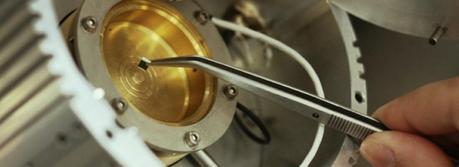 A HITECA capacitor (Credit: NPL)
A HITECA capacitor (Credit: NPL)
Hybrid and electric vehicles rely on high efficiency power conversion and management, with automotive power electronics representing an emerging $60 billion global market. Now, researchers at the National Physical Laboratory (NPL), UK, have created a new lead-free, high temperature ceramic capacitor that could improve the efficiency and reliability of electric and hybrid vehicles.
The power electronics found in vehicles today require cooling because of limitations in the temperature rating of components such as capacitors, which are used to store electrical energy. This is a disadvantage as the extra cooling systems add weight to the vehicles, reducing efficiency and reliability.
The Technology Strategy Board program for Low Carbon Vehicles funded scientists at NPL and their collaborators to work on a solution to this problem by developing a new ceramic capacitor dielectric material with a high energy density, called HITECA, which operates with a stable capacitance at temperatures of 200 °C (392 °F) and above.
The use of this material in electric and hybrid vehicles would reduce the need for cooling and the associated weight of the vehicles. Its high permittivity could enable smaller electronic devices and its reduced loss of capacitance with voltage could improve overall vehicle performance. Other types of capacitor, for example barium titanate capacitors, can lose up to 85% of their capacitance at working voltage.
As well as having applications in the automobile industry, HITECA capacitors could improve high temperature electronics in the aerospace, power, oil and gas sectors, and in high energy applications such as “pulsed power”—where energy is stored over a period of time before being released as a high power “pulse”.
Tatiana Correia, who led the work at NPL, said: “Industrial electronics need to be able to perform in the harsh environments in which they operate. The ability of HITECA capacitors to function at higher temperatures than existing capacitors will help make electronic systems more robust and remove barriers for technologies such as electric vehicles that rely on them.”
McMillen M., Douglas A.M., Correia T.M., Weaver P.M., Cain M.G., Gregg J.M. (2013). Increasing recoverable energy storage in electroceramic capacitors using “dead-layer” engineering Applied Physics Letters, 101 (24) DOI: 10.1063/1.4772016
